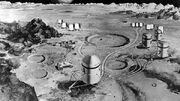
Mercury is the smallest and closest to the Sun of the eight planets in the Solar System, with an orbital period of about 88 Earth days. Seen from the Earth, it appears to move around its orbit in about 116 days, which is much faster than any other planet. This rapid motion may have led to it being named after the Roman deity Mercury, the fast-flying messenger to the gods. Since it has almost no atmosphere to retain heat, Mercury's surface experiences the greatest temperature variation of all the planets, ranging from 100 K (−173 °C; −280 °F) at night to 700 K (427 °C; 800 °F) during the day.
Exploration[]
Mercury was first visited by the Mariner 10 probe, in January 1974, the probe was originally designated to study both Venus and Mercury but after the Soviet surprised the world with a manned flyby of Venus. The United States decided to use the probe as a pathfinder and a technology demonstrator for a manned flyby of both these worlds to keep up with the Soviets in the early years of the Space Race.
The manned mission followed closely behind and while the probe made quick flyby of Mercury the American mission was able to orbit briefly and deliver a scientific payload to the surface. Several other American and Soviet orbital missions would continue over the next several years with the American landing three times.
In 1993, Japan became the second nation to land on Mercury. The Japanese set up a small temporary base in the hopes of finding "Rare Earths," which are needed in the electronics and differcult to get on earth as the largest resources are in war-torn China.
Colonies[]

Takao Doi was the first Japanese astronaut to land on Mercury and his mission found enough evidence of a deposit of Neodymium (used in advanced magnets) to warrent further investagation. With the discovery of Neodymium, it was hoped other rare elements may also be common, as the supplys of these elements are in short supply and are slow coming out of China which has the largest supplies.
With thge discovery of these rare earths, the United States and Japan started to build a joint base to further explore Mercury. In 1995, Cliffs Natural Resources a large American mining company open a mining operation.
Research Bases[]
The United States and the Soviet Union build a joint base as part of the Starship Project. The Soviets invited the Americans to jointly research anti-matter production. Mercury was chosen for safety, due to the distance from Earth and abundant solar energy which would be needed for any production of anti-matter

